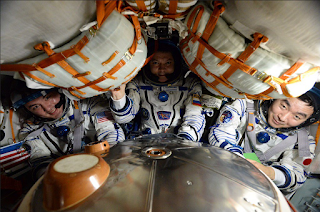Liftoff of Gemini V on the Titan II rocket from Pad LC-19.
Fifty years ago on August 21, 1965, astronauts Gordon Cooper, Jr. and Charles (Pete) Conrad, Jr., blasted off from Cape Canaveral for a long-duration mission around the Earth. The main mission was to study the effects of a mission lasting the time it would take to reach the Moon and return to the Earth. They would also practice orbiting rendezvous, by launching a targeting device and practicing maneuvering with it.
The entire crew of the Gemini V mission. From left to right, Backup crew Elliot See and Neil Armstrong, and Prime crew Pete Conrad and Gordon cooper.
"Gordo" Cooper would be the first astronaut to orbit the Earth for a second time. He had previously flown a 34-hour mission in the last Mercury flight, "Faith 7" and had been the last astronaut to fly alone. During that mission he was the first American to sleep in space, and relied on his superb piloting skills as several life support and flight controls broke down or gave him difficulty during the mission. He was in command of the Gemini V mission, which would turn out to be his last flight for NASA.
Astronauts move from the transport van to the gantry elevator.
"Pete" Conrad was making his first flight. He was a member of the "New Nine" batch of astronauts which would go on to be the prime crews for the later Apollo missions. He had been an excellent test pilot with the US Navy, and had a sarcastic sense of humor. He often referred to this mission as "Eight days in a garbage can" due to the cramped cockpit of the Gemini capsule.
Gemini V on the pad.
Service crew making final checks before closing the hatches on the Gemini capsule. This view gives a good view of the cramped quarters the astronauts would endure during the mission.
Panoramic view of the blastoff from Launch Complex 19. The launch control blockhouse is in the reinforced mound to the left. Today, that blockhouse is all that remains at the site.
NASA diagram of the new Fuel Cells in the Gemini service module behind the capsule. The new fuel cells were a vast improvement over the chemical-reaction batteries used in previous spacecraft, and made the long-duration flight possible.
The Radar Evaluation Pod. It was to be ejected in orbit, and used as a target for rendezvous practice.
After two hours in orbit, the crew ejected the REP (Radar Evaluation Pod). They would use the device to rendezvous with and maneuver, but Cooper detected a pressure loss in the Fuel cell. He shut it down while the craft was out of radio contact with mission control. It would mean that the rendezvous with the REP would have to be abandoned. After re-establishing contact, ground engineers calculated that the fuel cell could be turned back on and would not mean a cancellation of the rest of the mission objectives. On the ground, astronaut Buzz Aldrin calculated a new method for the orbiting crew to practice rendezvous by piloting to a fixed point in space.
Upper stage of the Titan II rocket, under recovery.
Down in the Atlantic, recovery crews located the upper stage of the Titan II rocket, which had kept floating due to the remaining gas in a nitrogen tank. It was recovered by the crew of the USS Dupont, and is on display today at the US Space and Rocket Center in Huntsville, Alabama. Meanwhile the crew continued on their mission to endure eight days in orbit.
























































